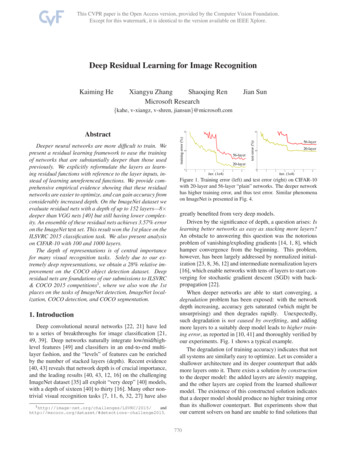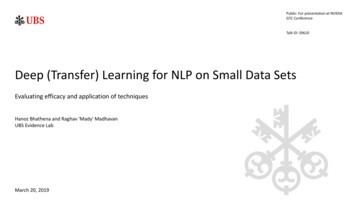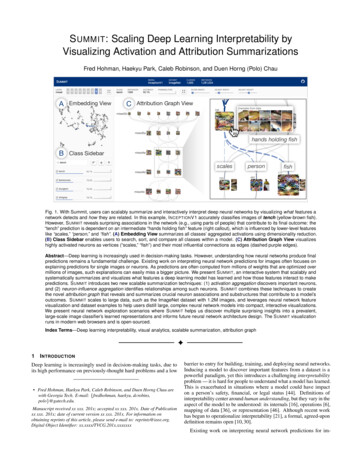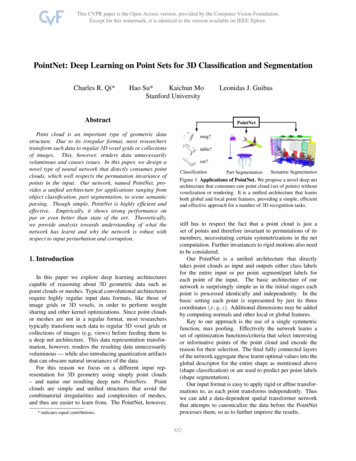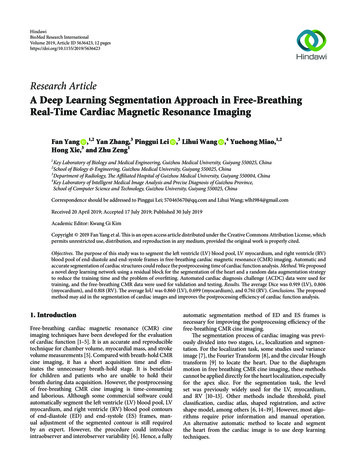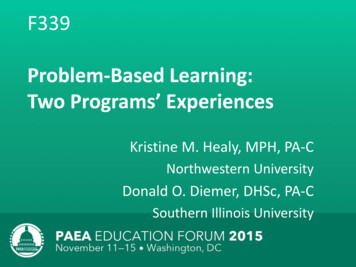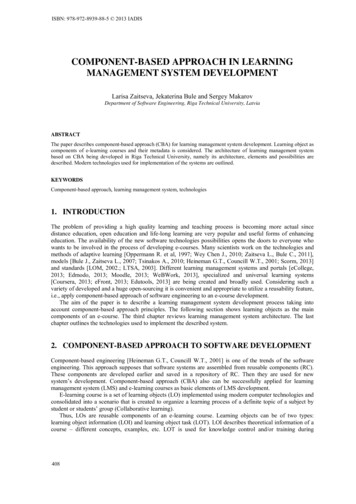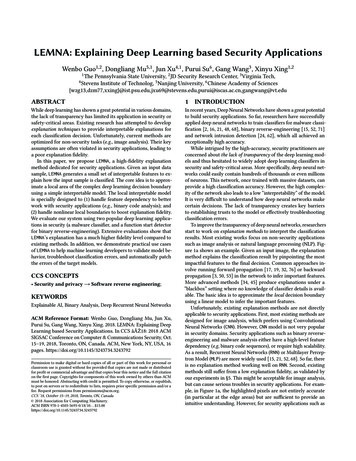
Transcription
LEMNA: Explaining Deep Learning based Security ApplicationsWenbo Guo1,2 , Dongliang Mu5,1 , Jun Xu4,1 , Purui Su6 , Gang Wang3 , Xinyu Xing1,21 ThePennsylvania State University, 2 JD Security Research Center, 3 Virginia Tech,Institute of Technolog, 5 Nanjing University, 6 Chinese Academy of ens.edu,purui@iscas.ac.cn,gangwang@vt.edu4 StevensABSTRACT1While deep learning has shown a great potential in various domains,the lack of transparency has limited its application in security orsafety-critical areas. Existing research has attempted to developexplanation techniques to provide interpretable explanations foreach classification decision. Unfortunately, current methods areoptimized for non-security tasks (e.g., image analysis). Their keyassumptions are often violated in security applications, leading toa poor explanation fidelity.In this paper, we propose LEMNA, a high-fidelity explanationmethod dedicated for security applications. Given an input datasample, LEMNA generates a small set of interpretable features to explain how the input sample is classified. The core idea is to approximate a local area of the complex deep learning decision boundaryusing a simple interpretable model. The local interpretable modelis specially designed to (1) handle feature dependency to betterwork with security applications (e.g., binary code analysis); and(2) handle nonlinear local boundaries to boost explanation fidelity.We evaluate our system using two popular deep learning applications in security (a malware classifier, and a function start detectorfor binary reverse-engineering). Extensive evaluations show thatLEMNA’s explanation has a much higher fidelity level compared toexisting methods. In addition, we demonstrate practical use casesof LEMNA to help machine learning developers to validate model behavior, troubleshoot classification errors, and automatically patchthe errors of the target models.In recent years, Deep Neural Networks have shown a great potentialto build security applications. So far, researchers have successfullyapplied deep neural networks to train classifiers for malware classification [2, 16, 21, 48, 68], binary reverse-engineering [15, 52, 71]and network intrusion detection [24, 62], which all achieved anexceptionally high accuracy.While intrigued by the high-accuracy, security practitioners areconcerned about the lack of transparency of the deep learning models and thus hesitated to widely adopt deep learning classifiers insecurity and safety-critical areas. More specifically, deep neural networks could easily contain hundreds of thousands or even millionsof neurons. This network, once trained with massive datasets, canprovide a high classification accuracy. However, the high complexity of the network also leads to a low “interpretability” of the model.It is very difficult to understand how deep neural networks makecertain decisions. The lack of transparency creates key barriersto establishing trusts to the model or effectively troubleshootingclassification errors.To improve the transparency of deep neural networks, researchersstart to work on explanation methods to interpret the classificationresults. Most existing works focus on non-security applicationssuch as image analysis or natural language processing (NLP). Figure 1a shows an example. Given an input image, the explanationmethod explains the classification result by pinpointing the mostimpactful features to the final decision. Common approaches involve running forward propagation [17, 19, 32, 76] or backwardpropagation [3, 50, 53] in the network to infer important features.More advanced methods [34, 45] produce explanations under a“blackbox” setting where no knowledge of classifier details is available. The basic idea is to approximate the local decision boundaryusing a linear model to infer the important features.Unfortunately, existing explanation methods are not directlyapplicable to security applications. First, most existing methods aredesigned for image analysis, which prefers using ConvolutionalNeural Networks (CNN). However, CNN model is not very popularin security domains. Security applications such as binary reverseengineering and malware analysis either have a high-level featuredependency (e.g, binary code sequences), or require high scalability.As a result, Recurrent Neural Networks (RNN) or Multilayer Perceptron Model (MLP) are more widely used [15, 21, 52, 68]. So far, thereis no explanation method working well on RNN. Second, existingmethods still suffer from a low explanation fidelity, as validated byour experiments in §5. This might be acceptable for image analysis,but can cause serious troubles in security applications. For example, in Figure 1a, the highlighted pixels are not entirely accurate(in particular at the edge areas) but are sufficient to provide anintuitive understanding. However, for security applications such asCCS CONCEPTS Security and privacy Software reverse engineering;KEYWORDSExplainable AI, Binary Analysis, Deep Recurrent Neural NetworksACM Reference Format: Wenbo Guo, Dongliang Mu, Jun Xu,Purui Su, Gang Wang, Xinyu Xing. 2018. LEMNA: Explaining DeepLearning based Security Applications. In CCS âĂŹ18: 2018 ACMSIGSAC Conference on Computer & Communications Security, Oct.15–19, 2018, Toronto, ON, Canada. ACM, New York, NY, USA, 16pages. https://doi.org/10.1145/3243734.3243792Permission to make digital or hard copies of all or part of this work for personal orclassroom use is granted without fee provided that copies are not made or distributedfor profit or commercial advantage and that copies bear this notice and the full citationon the first page. Copyrights for components of this work owned by others than ACMmust be honored. Abstracting with credit is permitted. To copy otherwise, or republish,to post on servers or to redistribute to lists, requires prior specific permission and/or afee. Request permissions from permissions@acm.org.CCS ’18, October 15–19, 2018, Toronto, ON, Canada 2018 Association for Computing Machinery.ACM ISBN 978-1-4503-5693-0/18/10. . . UCTION
binary analysis, incorrectly highlighting one byte of code may leadto serious misunderstandings or interpretation errors.Our Designs. In this paper, we seek to develop a novel, high-fidelityexplanation method dedicated for security applications. Our methodworks under a black-box setting and introduces specialized designsto address the above challenges. Given an input data instance xand a classifier such as an RNN, our method aims to identify a smallset of features that have key contributions to the classification ofx. This is done by generating a local approximation of the targetclassifier’s decision boundary near x. To significantly improve thefidelity of the approximation, our method no longer assumes thelocal detection boundary is linear, nor does it assume the featuresare independent. These are two key assumptions made by existingmodels [34, 45] which are often violated in security applications,causing a poor explanation fidelity. Instead, we introduce a newapproach to approximate the non-linear local boundaries based ona mixture regression model [27] enhanced by fused lasso [64].Our design is based on two key insights. First, a mixture regression model, in theory, can approximate both linear and non-lineardecision boundaries given enough data [35]. This gives us the flexibility to optimize the local approximation for a non-linear boundaryand avoid big fitting errors. Second, “fused lasso” is a penalty termcommonly used for capturing feature dependency. By adding fusedlasso to the learning process, the mixture regression model cantake features as a group and thus capture the dependency betweenadjacent features. In this way, our method produces high-fidelityexplanation results by simultaneously preserving the local nonlinearity and feature dependency of the deep learning model. Forconvenience, we refer to our method as “Local Explanation Methodusing Nonlinear Approximation” or LEMNA.Evaluations. To demonstrate the effectiveness of our explanationmodel, we apply LEMNA to two promising security applications:classifying PDF malware [55], and detecting the function start toreverse-engineer binary code [52]. The classifiers are trained on10,000 PDF files and 2,200 binaries respectively, and both achieve anaccuracy of 98.6% or higher. We apply LEMNA to explain their classification results and develop a series of fidelity metrics to assess thecorrectness of the explanations. The fidelity metrics are computedeither by directly comparing the approximated detection boundarywith the real one, or running end-to-end feature tests. The resultsshow that LEMNA significantly outperforms existing methods acrossall different classifiers and application settings.Going beyond the effectiveness assessment, we demonstrate howsecurity analysts and machine learning developers can benefit fromthe explanation results. First, we show that LEMNA could help toestablish trusts by explaining how classifiers make the correct decisions. In particular, for both binary and malware analyses, wedemonstrate the classifiers have successfully learned a number ofwell-known heuristics and “golden rules” in the respective domain.Second, we illustrate that LEMNA could extract “new knowledge”from classifiers. These new heuristics are difficult to be manuallysummarized in a direct way, but make intuitive sense to domainexperts once they are extracted by LEMNA. Finally, with LEMNA’s capability, an analyst could explain why the classifiers produce errors.This allows the analyst to automatically generate targeted patches3/20/18. Not worth the price for thedurability. Cool effects, .to a vacuum that lastsmore than 60 days .(a) Image classification.(b) Sentiment analysis.Figure 1: Examples of machine learning explanation: (a) theimage is classified as an “orange” due to the highlighted pixels; (b) The sentence is classified as “negative sentiment” dueto the highlighted keywords.by augmenting training samples for each of the explainable errors,and improve the classifier performance via targeted re-training.Contributions. Our paper makes three key contributions. We design and develop LEMNA, a specialized explanationmethod for deep learning based security applications. Usinga mixture regression model enhanced by fused lasso, LEMNAgenerates high-fidelity explanation results for a range ofdeep learning models including RNN. We evaluate LEMNA using two popular security applications,including PDF malware classification and function start detection in binary reverse-engineering. We propose a seriesof “fidelity” metrics to quantify the accuracy of the explanation results. Our experiments show that LEMNA outperformsexisting explanation methods by a significant margin. We demonstrate the practical applications of the explanationmethod. For both binary analysis and malware detection,LEMNA sheds lights on why the classifier makes correct andincorrect decisions. We present a simple method to automatically convert the insights into actionable steps to patch thetargeted errors of the classifiers.To the best our knowledge, this is the first explanation systemspecially customized for security applications and RNN. Our workis only the initial step towards improving the model transparencyfor more effective testing and debugging of deep learning models.By making the decision-making process interpretable, our effortscan make a positive contribution to building reliable deep learningsystems for critical applications.2EXPLAINABLE MACHINE LEARNINGIn this section, we start with introducing the background of explainable machine learning, and then discuss existing explanationtechniques. Following that, in Section §3, we introduce key securityapplications using deep learning models and discuss why existingexplanation techniques are not applicable to security applications.2.1Problem DefinitionExplainable machine learning seeks to provide interpretable explanations for the classification results. More specifically, given aninput instance x and a classifier C, the classifier will assign a labely for x during the testing time. Explanation techniques then aimto illustrate why instance x is classified as y. This often involvesidentifying a set of important features that make key contributionsto the classification process (or result). If the selected features are
interpretable to human analysts, then these features can offer an“explanation”. Figure 1 shows examples for image classificationand sentiment analysis. The classifier decision can be explained byselected features (e.g., highlighted pixels and keywords).In this paper, we focus on the deep neural networks to developexplanation methods for security applications. Up to the present,most existing explanation methods are designed for image analysis or NLP. We categorize them into “whitebox” and “blackbox”methods and describe how they work.2.2Most existing explanation techniques work under the whiteboxsetting where the model architecture, parameters, and trainingdata are known. These techniques are also referred as Deep Explanation Methods and mainly designed for CNN. They leverage twomajor strategies to infer feature importance: (1) forward propagation based input or structure occlusion; and (2) gradient-basedbackpropagation. We discuss those techniques in the following.Forward Propagation based Methods. Given an input sample,the key idea is to perturb the input (or hidden network layers)and observe the corresponding changes. The intuition behind isthat perturbing important features is more likely to cause majorchanges to the network structure and the classification output.Existing methods either nullify a subset of features or removingintermediate parts of the network [17, 32, 74, 76]. A recent work [19]extends this idea to detecting adversarial examples (i.e., maliciousinputs aiming to cause classification errors).Backward Propagation based Methods. Back-propagation basedmethods leverage the gradients of the deep neural network to inferfeature importance. The gradients can be the partial derivativesof classifier output with respect to the input or hidden layers. Bypropagating the output back to the input, these methods directlycalculate the weights of input features. For image classifiers, thebasic method is to compute a feature “saliency map” using the gradients of output with respect to the input pixels in images [54, 57]or video frames [18]. Later works improve this idea by applyingsaliency map layer by layer [3] or mapping groups of pixels [50].Backward propagation based methods face the challenge of “zerogradient”. Inside a neural network, the activation functions often have saturated parts, and the corresponding gradients willbecome zero. Zero gradients make it difficult (if not impossible) forthe “saliency map” to back-track the important features. Recentworks [53, 59] attempted to address this problem through approximation. However, this sacrifices the fidelity of the explanation [34].2.3Highest coefficientsattaching to 3 mostimportant featuresWhitebox Explanation MethodsBlackbox Explanation MethodsBlackbox explanation methods require no knowledge about theclassifier internals such as network architecture and parameters.Instead, they treat the classifier as a “blackbox” and analyze itby sending inputs and observing the outputs (i.e., Model InductionMethods).The most representative system in this category is LIME [45].Given an input x (e.g., an image), LIME systematically perturbs xto obtain a set of artificial images from the nearby areas of x inthe feature space (see x ′ and x ′′ in Figure 2). Then, LIME feeds theFigure 2: Illustrating how a Blackbox Explanation Methodworks. The key idea is to use a local linear model (д, the bluestraight line) to approximate the detection boundary f nearthe input instance x. Then the linear model can help to selectthe key contributing features to classifying x.artificial images to the target classifier f (x) to obtain labels, anduses the labeled data to fit a linear regression model д(x). Thisд(x) aims to approximate the small part of f (x) near the inputimage in the feature space. LIME assumes that the local area of theclassification boundary near the input instance is linear, and thus itis reasonable to use a linear regression model to locally representthe classification decision made by f (x). Linear regression is selfexplanatory, and thus LIME can pinpoint important features basedon the regression coefficients. A recent work SHAP [34] tries toextend LIME by adding weights to the artificially generated datasamples. Other works propose to use other linear models (e.g.,decision tree [6] and decision set [31]) to incrementally approximatethe target detection boundaries.As a side note, we want to clarify that machine learning explanation is completely different from feature selection methods suchas Principal Component Analysis (PCA) [26], Sparse Coding [39]or Chi-square Statistics [49]. Explanation methods aim to identifythe key features of a specific input instance x to specifically explainhow an instance x is classified. On the other hand, feature selectionmethods such as PCA are typically applied before training on thewhole training data to reduce the feature dimension (to speed upthe training or reduce overfitting), which cannot explain how aspecific classification decision is made.3EXPLAINING SECURITY APPLICATIONSWhile deep learning has shown a great potential to build securityapplications, the corresponding explanation methods are largelyfalling behind. As a result, the lack of transparency reduces the trust.First, security practitioners may not trust the deep learning modelif they don’t understand how critical decisions are made. Second,if security practitioners cannot troubleshoot classification errors(e.g., errors introduced by biased training data), the concern is thatthese errors may be amplified later in practice. In the following, weintroduce two key security applications where deep learning has recently achieved success. Then we discuss why existing explanationmethods are not applicable to the security applications.
Explanation tBlackboxG##Representative WorksWhitebox method (forward)Occlusion [17, 32, 74, 76], AI2 [19],Whitebox method (backword)Saliency Map [3, 54, 57], Grad-carm [50], DeepLIFT [53]Blackbox methodLIME [45], SHAP [34], Interpretable Decision Set [31]Our method LEMNALEMNATable 1: Design space of explainable machine learning for security applications ( true; # false; G# partially true).3.1Deep Learning in Security ApplicationsIn this paper, we focus on two important classes of security applications: binary reverse engineering and malware classification.Binary Reverse-Engineering. The applications of deep learningin binary analysis include identifying function boundaries [52],pinpointing the function type signatures [15] and tracking downsimilar binary code [71]. More specifically, using a bi-directionalRNN, Shin et al. improve the function boundary identification andachieve a nearly perfect performance [52]. Chua et al. also use RNNto accurately track down the arguments and types of functions inbinaries [15]. More recently, Xu et al. employ an MLP to encode acontrol flow graph to pinpoint vulnerable code fragments [71].Malware Classification. Existing works mainly use MLP modelsfor large-scale malware classifications. For example, researchershave trained MLP to detect malware at the binary code level [48] andclassify Android malware [2, 21]. More recently, Wang et al. [68]propose an adversarial resistant neural network for detecting malware based on audit logs [7].A key observation is that RNN and MLP are more widely adoptedby these security applications compared to CNN. The reason is thatRNN is designed to handle sequential data, which performs exceptionally well in processing the long sequences of binary code. Particularly, Bi-directional RNN can capture the bi-directional dependencies in the input sequences between each hex [52]. For malwareclassification, MLP is widely used for its high efficiency. On the otherhand, CNN performs well on images since it can take advantageof the grouping effect of features on the 2D images [30]. Thesesecurity applications do not have such “matrix-like” data structuresto benefit from using CNN.3.2Why Not Existing Explanation MethodsThere are key challenges to directly apply existing explanationmethods to the security applications. In Table 1, we summarize thedesired properties, and why existing methods fail to deliver them.Supporting RNN and MLP. There is a clear mismatch betweenthe model choices of the above security applications and existing explanation methods. Most existing explanation methods are designedfor CNN to work with image classifiers. However, as mentioned in§3.1, security applications of our interests primarily adopt RNN orMLP. Due to model mismatches, existing explanation methods arenot quite applicable. For example, the back-propagation methodsincluding “saliency map” [3, 18, 54, 57] and activation differencepropagation [53] require special operations on the convolutionallayers and pooling layers of CNN, which do not exist in RNN or MLP 1 .1 [15]presents some case studies using saliency map to explain RNN, but is forced toignore the feature dependency of RNN, leading to a low explanation fidelity.Best component LIME(a) Linear regression model.(b) Mixture regression model.Figure 3: Approximating a locally non-linear decisionboundary. The linear regression model (a) can easily makemistakes; Our mixture regression model (b) achieves a moreaccurate approximation.Blackbox methods such as LIME do not support RNN well either(validated by our experiments later). Methods like LIME assumefeatures are independent, but this assumption is violated by RNNwhich explicitly models the dependencies of sequential data.Supporting Locally Non-linear Decision Boundary. Most existing methods (e.g., LIME) assume the local linearity of the decisionboundary. However, when the local decision boundary is non-linear,which is true for most complex networks, those explanation methods would produce serious errors. Figure 3a shows an examplewhere the decision boundary around x is highly non-linear. Inother words, the linear part is heavily restricted to a very smallregion. The typical sampling methods can easily hit the artificialdata points beyond the linear region, making it difficult for a linearmodel to approximate the decision boundary near x. Later in ourexperiments (§ 5), we confirm that a simple linear approximationwill significantly degrade the explanation fidelity.Supporting Blackbox Setting. Although both whitebox and blackbox methods have their application scenarios, blackbox methods arestill more desirable for security applications. Noticeably, it is not uncommon for people to use pre-trained models (e.g., “Bi-directionalRNN” [52], “prefix tree” in Dyninst [5]) where the detailed network architecture, parameters or training data are not all available.Even though a few forward propagation methods can be forcedto work under a blackbox setting (by giving up the observationsof intermediate layers), it would inevitably lead to performancedegradation.Summary. In this paper, we aim to bridge the gaps by developing dedicated explanation methods for security applications. Ourmethod aims to work under a blackbox setting and efficiently support popular deep learning models such as RNN, MLP, and CNN. Moreimportantly, the method need to achieve a much higher explanationfidelity to support security applications.
4OUR EXPLANATION METHODTo achieve the above goals, we design and develop LEMNA. At thehigh-level, we treat a target deep learning classifier as a blackboxand derive explanation through model approximation. In order toprovide a high fidelity explanation, LEMNA needs to take a verydifferent design path from existing methods. First, we introducefused lasso [64] to handle the feature dependency problems that areoften encountered in security applications and RNN (e.g., time seriesanalysis, binary code sequence analysis). Then, we integrate fusedlasso into a mixture regression model [28] to approximate locally nonlinear decision boundaries to support complex security applications.In the following, we first discuss the insights behind the designchoices of using fused lasso and mixture regression model. Then,we describe the technical details to integrate them into a singlemodel to handle feature dependencies and locally nonlinearity atthe same time. Finally, we introduce additional steps to utilize LEMNAto derive high-fidelity explanations.4.1Insights behind Our DesignsFused Lasso. Fused lasso is a penalty term commonly used forcapturing feature dependencies, and is useful to handle the dependent features in deep learning models such as RNN. At the high-level,“fused lasso” forces LEMNA to group relevant/adjacent features together to generate meaningful explanations. Below, we introducethe technical details of this intuition.To learn a model from a set of data samples, a machine learningalgorithm needs to minimize a loss function L( f (x), y) that definesthe dissimilarity between the true label and the predicted label bythe model. For example, to learn a linear regression model f (x) βx ϵ from a data set with N samples, a learning algorithm needsto minimize the following equation with respect to the parameterβ using Maximum Likelihood Estimation (MLE) [38].L( f (x), y) NX βxi yi .(1)i 1Here, xi is a training sample, represented by an M-dimensionalityfeature vector (x 1 , x 2 , · · · , x M )T . The label of xi is denoted as yi .The vector β (β 1 , β 2 , · · · β M ) contains the coefficients of the linear model. · is the L2-norm measuring the dissimilarity betweenthe model prediction and the true label.Fused lasso is a penalty term that can be introduced into anyloss functions used by a learning algorithm. Take linear regressionfor example. Fused lasso manifests as a constraint imposed uponcoefficients, i.e.,L( f (x), y) NX βxi yi ,i 1subject toMX(2) β j β j 1 S .j 2Fused lasso restricts the dissimilarity of coefficients assigned to adjacent features within a small threshold S (i.e., a hyper-parameter)when a learning algorithm minimizes the loss function. As a result, the penalty term forces a learning algorithm to assign equalweights to the adjacent features. Intuitively, this can be interpretedas forcing a learning algorithm to take features as groups and thenlearn a target model based on feature groups.Security applications, such as time series analysis and code sequence analysis, often need to explicitly model the feature dependency of sequential data using RNN. The resulting classifier makesa classification decision based on the co-occurrence of features. Ifwe use a standard linear regression model (e.g., LIME) to derivean explanation, we cannot approximate a local decision boundarycorrectly. This is because a linear regression model cannot capturefeature dependency and treat them independently.By introducing fused lasso in the process of approximating localdecision boundary, we expect the resulting linear model to havethe following form:f (x) β 1x 1 β 2 (x 2 x 3 ) β 3 (x 4 x 5 ) · · · βk x M ,(3)where features are grouped together and thus important featuresare likely to be selected as a group or multiple groups. Explicitlymodeling this process in LEMNA helps to derive a more accurateexplanation, particularly for the decision made by an RNN. We further explain this idea using an example of sentiment analysis inFigure 1b. With the help of fused lasso, a regression model wouldcollectively consider adjacent features (e.g., words next to eachother in a sentence). When deriving the explanations, our modeldoes not simply yield a single word “not”2 , but can accurately capture the phrase “not worth the price” as the explanation for thesentiment analysis result.Mixture Regression Model. A mixture regression model allowsus to approximate locally nonlinear decision boundaries more accurately. As shown in Figure 3b, a mixture regression model is acombination of multiple linear regression models, which makes itmore expressive to perform the approximation:y KXπk (β k x ϵk ) ,(4)k 1where K is a hyper-parameter indicating the total number of linear components combined in the mixture model; πk indicates theweight assigned to that corresponding component.Given sufficient data samples, whether the classifier has a linearor non-linear decision boundary, the mixture regression modelcan nearly perfectly approximate the decision boundary (using afinite set of linear models) [35]. As such, in the context of deeplearning explanation, the mixture regression model can help avoidthe aforementioned non-linearity issues and derive more accurateexplanations.To illustrate this idea, we use the example in Figure 3. As shownin Figure 3a, a standard linear approximation cannot guarantee thedata sampled around the input x still remain in the locally linearregion. This can easily lead to imprecise approximation and lowfidelity explanations. Our method in Figure 3b approximates thelocal decision boundary with a polygon boundary, in which eachblue line represents an independent linear regression model. Thebest linear model for producing the explanation should be the redline passing through the data point x. In this way, the approximationprocess can yield an optimal linear regression model for pinpointingimportant features as the explanation.2 Insentiment analysis, “not” does not always carry negative sentiment, e.g., “not bad”.
4.2Model DevelopmentNext, we convert these design insights into a functional explanationsystem. We introduce the technical steps to integrate fused lasso inthe learning process o
We demonstrate the practical applications of the explanation method. For both binary analysis and malware detection, LEMNA sheds lights on why the classifier makes correct and incorrect decisions. We present a simple method to automat-ically convert the insights into actionab


